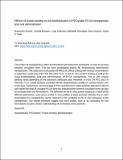| dc.description.abstract | The surface of nanoparticles is often functionalised with polymeric surfactants, in order to increase systemic circulation time. This has been investigated mainly for intravenously administered nanoparticles. This study aims to elucidate the effect of surface coating with various concentrations of polymeric surfactants (PEG and Pluronics F127) on the in vitro protein binding as well as the tissue biodistribution, post oral administration, of PLGA nanoparticles. The in vitro protein binding varied depending on the polymeric surfactant used. However, in vivo, 1% PEG and 1% Pluronics F127 coated particles presented similar biodistribution profiles in various tissues over seven days. Furthermore, the percentage of PEG and Pluronics coated particles detected in plasma was higher than that of uncoated PLGA particles, indicating that systemic circulation time can also be increased with oral formulations. The difference in the in vitro protein binding as a result of the different poloxamers used versus similar in vivo profiles of these particles indicates that in vitro observations for nanoparticles cannot represent or be correlated to the in vivo behaviour of the nanoparticles. Our results therefore suggest that more studies have to be conducted for oral formulations to give a better understanding of the kinetics of the particles. | en_US |

